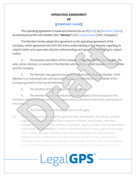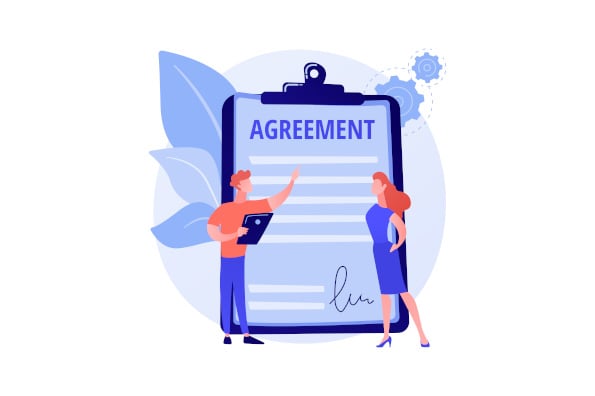1 min read
Independent Contractor vs. Employee: Key Differences for Business Owners
Being an employer comes with a lot of responsibilities: there’s the subject of taxes, insurance, training, and a whole range of other obligations to...
5 min read
LegalGPS : Oct. 7, 2024
If you're a business owner looking for ways to expand your business reach, entering into a distribution agreement could be just the ticket. It may sound a little complex, but it's a pretty common practice which we’re going to break down in simple, approachable terms.


Distribution Agreement
Access our Distribution Agreement Template to outline terms between manufacturers and distributors. Ensure mutual understanding and protection.
Trusted by 1,000+ businesses to safeguard their LLCs.
A Distribution Agreement is a legal contract that lays out the terms between a supplier (or manufacturer) and a distributor. In this agreement, the supplier agrees to sell their products to the distributor, who then goes on to sell these products to the end consumer. It's like a roadmap that directs the product journey from the manufacturer's warehouse to the customer's doorstep.
This agreement can be a great advantage to your business strategy. It can help you gain a larger market share, break into new markets, or even boost your production by manufacturing large quantities of products due to the extra reach.
So, why should you as a business owner, consider a Distribution Agreement? The answer is straightforward: it's the legal safety net you need when you decide to spread your products far and wide. A well written Distribution Agreement ensures that your company's interests are protected, and the duties of both parties are clearly outlined.
It's all about setting clear expectations – this not only minimizes possible disputes but also contributes to the smooth running of your supply chain. Doing so will also help your business avoid any potential legal issues down the road. So, if you're looking for a distributor for your products and want to make sure that both parties are protected, consider having a Distribution Agreement drafted.
Every Distribution Agreement has some core components that make it legally binding and professionally worthwhile. We’ll look into the main elements that you should be aware of when drafting your agreement:
Parties involved: This includes the supplier or manufacturer and the distributor. Names and addresses are needed for identification.
Term of Agreement: Details on when the agreement starts, how long it lasts, and under what circumstances it may be terminated.
Products: Comprehensive details of the products to be distributed need to be clearly defined.
Territory: This outlines where the distributor is permitted to sell the products.
Distributor Obligations: What is the distributor expected to do? This section can include things like sales targets, marketing efforts, and report requirements.
Pricing and Payment Terms: How and when will the distributor pay the supplier for the products? Are there any conditions affecting the pricing?
Understanding all these elements can give you control over your business dealings and a sense of ease in the complexity of it all.
Coaching Agreement Benefits for Professionals
Creating a robust Distribution Agreement may seem daunting, especially if you're new to the legal terminology and contractual obligations. Let’s walk through how to get started:
First, you need to insert the names and business addresses of the supplier and distributor at the top of the agreement. This is typically done in the opening statement, often called the "preamble" or the "recitals." A simple and clear way to write this would be something like:
|
Example “This Distribution Agreement ("Agreement") is made on [insert date], by and between [Supplier's full legal name], a corporation incorporated under the laws of [insert jurisdiction and address] ("Supplier"), and [Distributor's full legal name], a [corporate structure and jurisdiction, and address] ("Distributor").” |
Next, you need to provide comprehensive details of the specific products that will be distributed and where exactly the distributor can sell these products. You should create a new clause titled "Scope of the Agreement" to outline this. For example:
|
Example “The Distributor is hereby appointed as the exclusive distributor of [description of products] ("Products") for resale in the territory of [define geographical area] ("Territory") and no other.” |
Take your time here, clarify each product - use product codes, names, categories, or any specific identifiers relevant to the products to avoid confusion.


Legal GPS Pro
Protect your business with our complete legal subscription service, designed by top startup attorneys.
Create another clause named “Term and Termination.” Here, outline the duration of the agreement, starting from the 'Effective Date.' For instance:
|
Example “This Agreement shall come into effect on [date] and shall continue for a period of [insert number] years unless terminated earlier in accordance with the provisions of this Agreement.” |
And speaking about termination, make sure to specify situations where parties can terminate the agreement, including any notice period.
In the "Pricing and Payment Terms" section, describe the pricing of the distributed products and terms of payments. You might write:
|
Example “The price of each Product shall be the Supplier's price, as indicated on the current price list that the Supplier provides the Distributor. The Distributor will make payments within [insert number] days of the invoice date.” |
Also, consider any conditions that might affect pricing such as discounts, price adjustments, etc.
Get Your Distribution Agreement Template
with a Legal GPS Subscription
In the sections "Supplier's Obligations" and "Distributor's Obligations," specifically detail what each party is expected to do. This includes marketing efforts, minimum sales targets, handling defective items, providing after-sales support, payment terms, etc. The more specific you are in these sections, the less room there is for misinterpretation.
Even with a clear guideline, people often make mistakes when drafting Distribution Agreements. Being privy to potential errors can save you unnecessary headaches down the road. Here are some common pitfalls:
Always be as specific as possible when outlining the products and territories in your Distribution Agreement. Failure to do so can lead to confusion about what is being distributed. For example, if you list “all goods manufactured by Company A” but don’t specify what those goods are, it could be unclear if your distributor is only allowed to sell certain items or all of them. This can be especially problematic when the manufacturer has multiple products.
The more details, the better! Clearly state the obligations of the distributor and the supplier to set the expectations right from the start. For example, if you’re an international company, you may want to specify that your distributors only sell your products in their territory and not outside of it. You also want to make sure they understand how they are expected to promote and sell your product. For example, if you require them to take part in trade shows or other marketing activities, ensure that this is included in the agreement.

Distribution Agreement
Access our Distribution Agreement Template to outline terms between manufacturers and distributors. Ensure mutual understanding and protection.
Trusted by 1,000+ businesses to safeguard their LLCs.
Being prepared for every situation is key. Be sure to define what circumstances would lead to termination of the agreement. Make sure that these conditions are fair and reasonable, but also make sure they’re enforceable. For example, if you want to terminate the agreement if your distributor fails to meet their sales quota for three months in a row, make sure there is some way for you to prove that this is the case.
Entering into a distribution agreement can open up a world of opportunities for your business. It might seem complex, but with proper understanding and attention to detail, it can be a smooth process. Remember, this guide exists to help you navigate the ins and-outs of Distribution Agreements, but if you're still unsure, check out our customizable template!
We'll be here to help demystify any other legal jargon you come across on your business journey, so stay tuned!
The biggest question now is, "Do I need a business lawyer?” For most businesses and in most cases, you don't need a lawyer to start your business. Instead, many business owners rely on Legal GPS Pro to help with legal issues.
Legal GPS Pro is your All-In-One Legal Toolkit for Businesses. Developed by top startup attorneys, Pro gives you access to 100+ expertly crafted templates including operating agreements, NDAs, and service agreements, and an interactive platform. All designed to protect your company and set it up for lasting success.
Get Legal GPS's Distribution Agreement Template Now

Legal GPS Pro
Protect your business with our complete legal subscription service, designed by top startup attorneys.
|
Premium Template
Single-use Template |
Legal GPS Pro
Unlimited Access, Best Value |
|
|
| Choose Template | Learn More |
| Trusted by 1000+ businesses | |
Table of Contents

1 min read
Being an employer comes with a lot of responsibilities: there’s the subject of taxes, insurance, training, and a whole range of other obligations to...

Businesses that experience an influx of seasonal work or need specialized skills often look to hire independent contractors rather than employees....

When you're in the catering business, you quickly realize that every event is different, and success depends on meeting various expectations. That's...